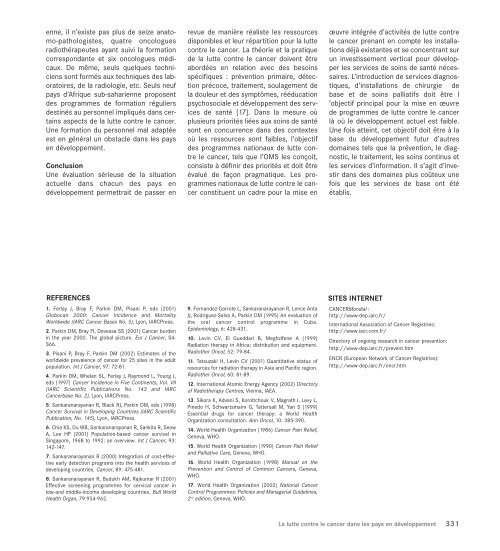Le cancer, un fardeau mondial - IARC
Le cancer, un fardeau mondial - IARC
Le cancer, un fardeau mondial - IARC
Create successful ePaper yourself
Turn your PDF publications into a flip-book with our unique Google optimized e-Paper software.
enne, il n’existe pas plus de seize anatomo-pathologistes,<br />
quatre oncologues<br />
radiothérapeutes ayant suivi la formation<br />
correspondante et six oncologues médicaux.<br />
De même, seuls quelques techniciens<br />
sont formés aux techniques des laboratoires,<br />
de la radiologie, etc. Seuls neuf<br />
pays d’Afrique sub-saharienne proposent<br />
des programmes de formation réguliers<br />
destinés au personnel impliqués dans certains<br />
aspects de la lutte contre le <strong>cancer</strong>.<br />
Une formation du personnel mal adaptée<br />
est en général <strong>un</strong> obstacle dans les pays<br />
en développement.<br />
Conclusion<br />
Une évaluation sérieuse de la situation<br />
actuelle dans chac<strong>un</strong> des pays en<br />
développement permettrait de passer en<br />
revue de manière réaliste les ressources<br />
disponibles et leur répartition pour la lutte<br />
contre le <strong>cancer</strong>. La théorie et la pratique<br />
de la lutte contre le <strong>cancer</strong> doivent être<br />
abordées en relation avec des besoins<br />
spécifiques : prévention primaire, détection<br />
précoce, traitement, soulagement de<br />
la douleur et des symptômes, rééducation<br />
psychosociale et développement des services<br />
de santé [17]. Dans la mesure où<br />
plusieurs priorités liées aux soins de santé<br />
sont en concurrence dans des contextes<br />
où les ressources sont faibles, l’objectif<br />
des programmes nationaux de lutte contre<br />
le <strong>cancer</strong>, tels que l’OMS les conçoit,<br />
consiste à définir des priorités et doit être<br />
évalué de façon pragmatique. <strong>Le</strong>s programmes<br />
nationaux de lutte contre le <strong>cancer</strong><br />
constituent <strong>un</strong> cadre pour la mise en<br />
œuvre intégrée d’activités de lutte contre<br />
le <strong>cancer</strong> prenant en compte les installations<br />
déjà existantes et se concentrant sur<br />
<strong>un</strong> investissement vertical pour développer<br />
les services de soins de santé nécessaires.<br />
L’introduction de services diagnostiques,<br />
d’installations de chirurgie de<br />
base et de soins palliatifs doit être l<br />
’objectif principal pour la mise en œuvre<br />
de programmes de lutte contre le <strong>cancer</strong><br />
là où le développement actuel est faible.<br />
Une fois atteint, cet objectif doit être à la<br />
base du développement futur d’autres<br />
domaines tels que la prévention, le diagnostic,<br />
le traitement, les soins continus et<br />
les services d’information. Il s’agit d’investir<br />
dans des domaines plus coûteux <strong>un</strong>e<br />
fois que les services de base ont été<br />
établis.<br />
REFERENCES<br />
1. Ferlay J, Bray F, Parkin DM, Pisani P, eds (2001)<br />
Globocan 2000: Cancer Incidence and Mortality<br />
Worldwide (<strong>IARC</strong> Cancer Bases No. 5), Lyon, <strong>IARC</strong>Press.<br />
2. Parkin DM, Bray FI, Devessa SS (2001) Cancer burden<br />
in the year 2000. The global picture. Eur J Cancer, S4-<br />
S66.<br />
3. Pisani P, Bray F, Parkin DM (2002) Estimates of the<br />
worldwide prevalence of <strong>cancer</strong> for 25 sites in the adult<br />
population. Int J Cancer, 97: 72-81.<br />
4. Parkin DM, Whelan SL, Ferlay J, Raymond L, Yo<strong>un</strong>g J,<br />
eds (1997) Cancer Incidence in Five Continents, Vol. VII<br />
(<strong>IARC</strong> Scientific Publications No. 143 and <strong>IARC</strong><br />
Cancerbase No. 2), Lyon, <strong>IARC</strong>Press.<br />
5. Sankaranarayanan R, Black RJ, Parkin DM, eds (1998)<br />
Cancer Survival in Developing Co<strong>un</strong>tries (<strong>IARC</strong> Scientific<br />
Publication, No. 145), Lyon, <strong>IARC</strong>Press.<br />
6. Chia KS, Du WB, Sankaranarayanan R, Sankila R, Seow<br />
A, <strong>Le</strong>e HP (2001) Population-based <strong>cancer</strong> survival in<br />
Singapore, 1968 to 1992: an overview. Int J Cancer, 93:<br />
142-147.<br />
7. Sankaranarayanan R (2000) Integration of cost-effective<br />
early detection programs into the health services of<br />
developing co<strong>un</strong>tries. Cancer, 89: 475-481.<br />
8. Sankaranarayanan R, Budukh AM, Rajkumar R (2001)<br />
Effective screening programmes for cervical <strong>cancer</strong> in<br />
low-and middle-income developing co<strong>un</strong>tries. Bull World<br />
Health Organ, 79:954-962.<br />
9. Fernandez-Garrote L, Sankaranarayanan R, <strong>Le</strong>nce Anta<br />
JJ, Rodriguez-Salva A, Parkin DM (1995) An evaluation of<br />
the oral <strong>cancer</strong> control programme in Cuba.<br />
Epidemiology, 6: 428-431.<br />
10. <strong>Le</strong>vin CV, El Gueddari B, Meghzifene A (1999)<br />
Radiation therapy in Africa: distribution and equipment.<br />
Radiother Oncol, 52: 79-84.<br />
11. Tatsuzaki H, <strong>Le</strong>vin CV (2001) Quantitative status of<br />
resources for radiation therapy in Asia and Pacific region.<br />
Radiother Oncol, 60: 81-89.<br />
12. International Atomic Energy Agency (2002) Directory<br />
of Radiotherapy Centres, Vienna, IAEA.<br />
13. Sikora K, Advani S, Koroltchouk V, Magrath I, <strong>Le</strong>vy L,<br />
Pinedo H, Schwartsmann G, Tattersall M, Yan S (1999)<br />
Essential drugs for <strong>cancer</strong> therapy: a World Health<br />
Organization consultation. Ann Oncol, 10: 385-390.<br />
14. World Health Organization (1986) Cancer Pain Relief,<br />
Geneva, WHO.<br />
15. World Health Organization (1990) Cancer Pain Relief<br />
and Palliative Care, Geneva, WHO.<br />
16. World Health Organization (1998) Manual on the<br />
Prevention and Control of Common Cancers, Geneva,<br />
WHO.<br />
17. World Health Organization (2002) National Cancer<br />
Control Programmes: Policies and Managerial Guidelines,<br />
2 nd edition, Geneva, WHO.<br />
SITES INTERNET<br />
CANCERMondial :<br />
http://www-dep.iarc.fr/<br />
International Association of Cancer Registries:<br />
http://www.iacr.com.fr/<br />
Directory of ongoing research in <strong>cancer</strong> prevention:<br />
http://www-dep.iarc.fr/prevent.htm<br />
ENCR (European Network of Cancer Registries):<br />
http://www-dep.iarc.fr/encr.htm<br />
La lutte contre le <strong>cancer</strong> dans les pays en développement 331
















